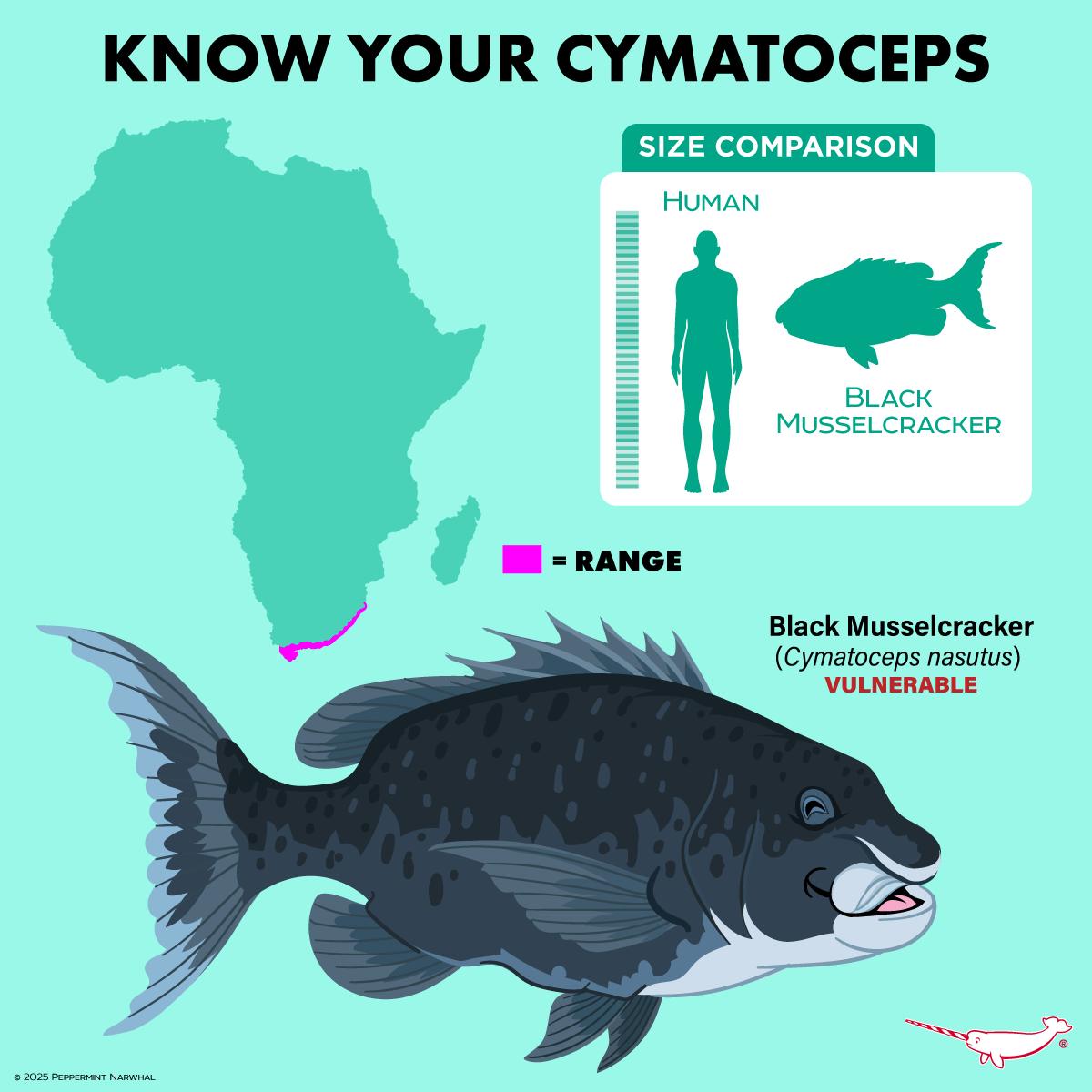- Understanding the biology and habitat of the Black Musselcracker (Cymatoceps nasutus).
- Discussion of the species’ reproductive traits and lifecycle, including protogynous hermaphroditism.
- Importance of the Black Musselcracker to sport fishing and the impact of overfishing.
- Conservation status and efforts needed to protect this vulnerable species.
- Broader implications for marine ecosystems and human interactions with marine life.
The Cymatoceps genus, specifically Cymatoceps nasutus, commonly known as the Black Musselcracker, presents an intriguing subject for aquatic enthusiasts and researchers. This monotypic genus is characterized by its sole member, an impressive species that roams the shallow, rocky shorelines of southern Africa. Its habitat features a vibrant underwater world marked by rugged landscapes, where these large fish utilize their powerful jaws to prey on mollusks, crustaceans, and echinoderms. The biodiversity in these coastal waters provides a fascinating backdrop for the life of the Black Musselcracker, making it a vital component of the marine ecosystem.
The Black Musselcracker stands out not only for its size but also for its distinctive fleshy white snout, reminiscent of the late actor, Jimmy Durante. Its robust physique and strong facial structure underscore its role as a predator in its habitat. This species is equipped with formidable teeth and jaws, enabling it to feast on hard-shelled creatures. Consequently, it plays an essential part in maintaining the balance within its food web, helping control the populations of its prey and thereby ensuring the health of the ecosystem it inhabits.
A particularly captivating aspect of Cymatoceps nasutus is its reproductive biology, which features a process called protogynous hermaphroditism. Such a reproductive strategy is not uncommon among fish species; however, it highlights the Black Musselcracker’s capacity for adaptation. Protogynous hermaphrodites are organisms that begin their lives as females and later transform into males, typically triggered by factors such as size, age, or environmental conditions. For Black Musselcrackers, this transformation generally occurs when they reach around 18 years of age and approximately 28 inches (70 cm) in length. This advanced reproductive tactic contributes to the species’ evolutionary resilience, ensuring a balanced ratio of males to females and increasing the chances of successful reproduction.
The allure of the Black Musselcracker extends beyond its ecological role, drawing the interest of anglers worldwide. The species’ imposing presence and challenging catch make it a sought-after prize in sport fishing circles. However, this popularity comes with a downside: overfishing. Excessive fishing activities have led to a decline in Black Musselcracker populations, threatening their ability to sustain themselves. The demand for this notable fish, combined with unsustainable fishing practices, underscores the urgent need for effective management and conservation strategies.
Listed as Vulnerable on the IUCN Red List of Threatened Species, the Black Musselcracker’s status is a cause for concern. This classification indicates that the species faces a high risk of extinction in the wild unless immediate action is taken to counteract the factors contributing to its decline. Conservation efforts, such as establishing protected marine areas, enforcing catch limits, and promoting sustainable fishing practices, are crucial to preserving this species for future generations. It’s essential to cultivate a better understanding and respect for the Black Musselcracker, emphasizing its importance beyond recreational fishing.
Preserving the Black Musselcracker is imperative not just for maintaining biodiversity but also for the health of marine ecosystems. By protecting such species, we are safeguarding the complex interactions that sustain life beneath the waves. The decline of key species like the Black Musselcracker can have cascading effects, disrupting ecological balance and affecting the many other organisms that share its habitat. In this context, both governmental and non-governmental organizations have a role to play by promoting educational programs that emphasize marine conservation and foster a deeper appreciation for oceanic life.
Human activities, including pollution and habitat destruction, further exacerbate the threats faced by the Black Musselcracker. Addressing these issues requires a cooperative approach that unites various stakeholders, including governments, conservationists, fishers, and the general public. Efforts should focus on reducing bycatch, protecting spawning grounds, and implementing stricter regulations on fishing practices.
In summary, the Cymatoceps genus, represented by its sole species, the Black Musselcracker, offers a lens through which we can appreciate the intricacies of marine life. Understanding its biology, reproductive strategies, and ecological importance helps underscore the significance of conservation efforts. It is an important reminder that humans have both a responsibility and the capacity to make informed choices that benefit not only a single species but the wider environment. As stewards of the planet, it falls upon us to balance our pursuits with the health and longevity of the natural world, ensuring that species like the Black Musselcracker continue to thrive in their rightful habitats.
*****
Source Description
Know Your Cymatocaeps
The Cymatoceps genus is monotypic and contains only the distinctive Black Musselcracker(Cymatoceps nasutus). It inhabits shallow, rocky coastal areas of southern Africa. The species is distinguished by fleshy white snout that would rival the late actor, Jimmy Durante. It feeds on mollusks, crustaceans, echinoderms. and other hard-shelled animals. The species species is thought to exhibit protogynous hermaphroditism. Protogynous hermaphrodites are animals that are born female and at some point in their lifespan change sex to male. Large females changing into makes at about 18 years of age and 28 inches (70 cm) in length. The large size and unique character of the Black Musselcracker has made is a popular sports fish, but overfishing has put a strain on the species and populations are declining. Currently, the species is listed as Vulnerable on the IUCN Red List of Threatened Species. Now You Know Your Cymatocaeps!
Happy Monotypic Monday!
FISH MERCH: https://www.peppermintnarwhal.com/s/search?q=fish%20deep%20lake
ANIMAL HOLIDAY CALENDAR – ONLY $10 – LAST CHANCE!
Shop www.peppermintnarwhal.com
International Shoppers visit our store on Etsy:
www.etsy.com/shop/PeppermintNarwhal


